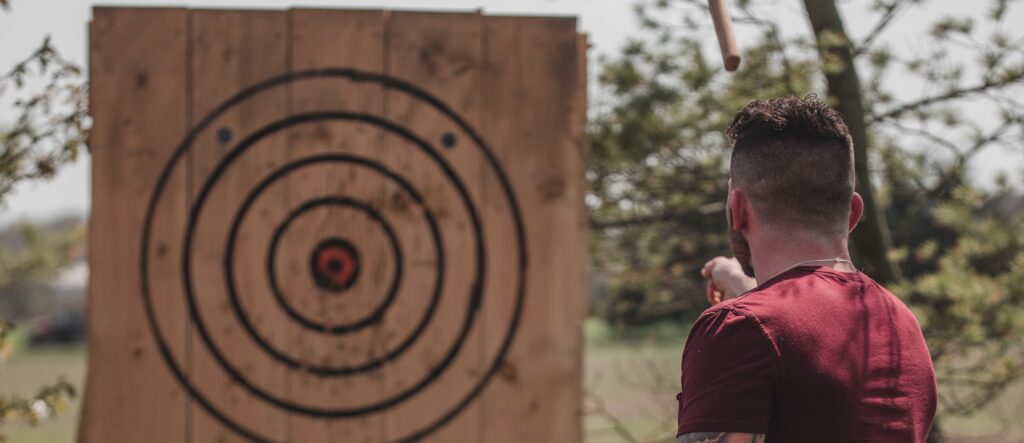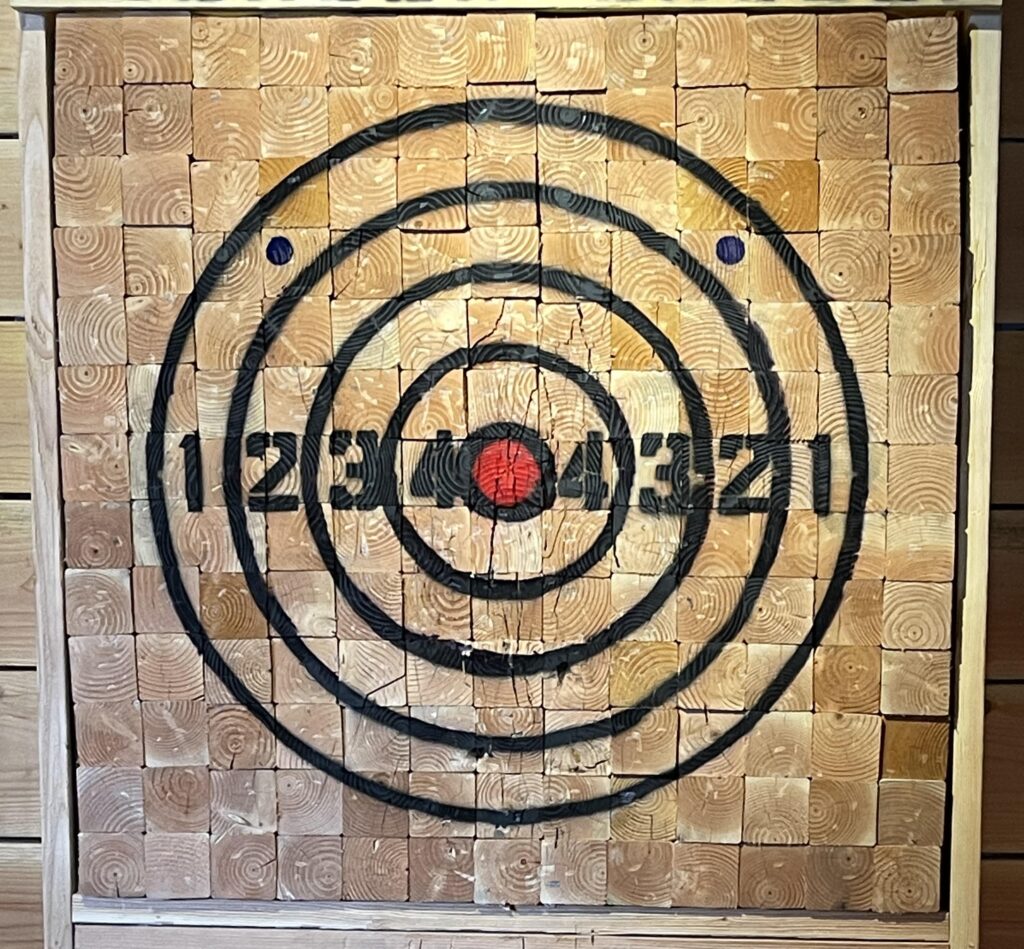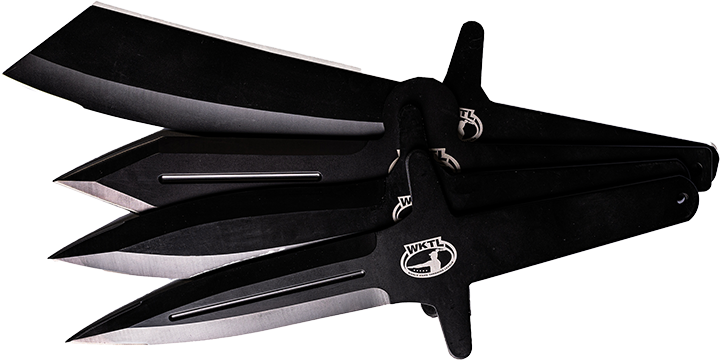As the first Commissioner of the World Knife Throwing League there has been a great deal of learning. While my time as the Commissioner of the World Axe Throwing League certainly helped, there was still a great deal of knowledge that is different though there is much the same as well. I’ve researched and tested a great deal of knife throwing knowledge from historical documents, to feedback from the current knife throwing community, and my own personal experiences. However, the most important aspect of all of the knife throwing knowledge I’ve received has been about knife throwing safety practices. So I’ve put together a comprehensive list of tips from all of that knowledge for you here to make sure that you can participate in this wonderful sport without worry.
I’ve broken down the safety tips into different elements so you can practice knife throwing safety. These are the key elements:
The first and easiest option is to find your local WKTL affiliated throwing venue! They have gone over all the safety requirements we have in the league and have everything ready for you to just walk in and start throwing. But if you’re looking to make your own throwing space or hoping to open a throwing venue then here are some ideas that can help you along the way.
The right location: Find a dedicated and controlled space that gives you plenty of space to throw as well as space around the throwing area so there’s no risk of anything getting in between you and the target when you are throwing, and that nothing you can damage is anywhere nearby the target either.
We recommend that you find an area of about 10ft ceiling height (if indoors) and that you have a total of 6ft minimum space to the sides of your throwing area as well as about 18ft from your target outwards. Please note that depending on your targets you may need to allow extra room as well!
Whether indoors or outdoors if you’re able to clear this amount of space and ensure nothing will cross into it while throwing then you’ll have a safe area to begin your throwing!
Next you’ll need a target. There are three main styles of targets used, boards, log rounds, and end grain. For wood type, Cottonwood or Poplar is best but any soft wood will do.

Board Targets: We have a full instruction list to build a target here. They are arguably the safest option you can make but the one thing you’ll need to be sure of is the space behind those targets in case a thrower misses the target. It would be best to have something to prevent knives from passing by the target or to make sure you have enough space behind it and that it is also clear of anything that could be damaged. If you’d like to follow league specifications you can find that info here on the WKTL rules page.
Log Rounds: These are the easiest and most widely available option for targets but their downside is they’re a bit harder to set up safely. Some folks will stack log rounds on top of each other using the weight of the logs to stay steady but make sure they are braced on something and won’t tip over or fall. They also have an issue that there are gaps between the logs sometimes so filling those to make sure a knife doesn’t pass through is important

End Grain: End grain targets are typically a collection of boards that are put together in a frame. They will take a bit more time to put together but can last quite a while. You’ll just need to make sure your frame is securely attached to where you intend to throw.
For maximum target safety, please make sure that whatever targets you are using are securely attached or grounded. A bit of force to ensure the targets don’t wobble or fall before you throw is very important.
When looking at safe throwing knives there are some key elements to consider.

Make sure you use knives made from durable, high-quality materials (e.g., stainless steel or carbon steel) that won’t break or splinter upon impact.
A common misconception for throwing knife is that they should be sharp all along the blade but this isn’t needed for throwing and I advise against it. Having a good point on the knife is all you need so to maximize safety, ensure your throwing knives have dull edges and a pointed tip to minimize the risk of cutting injuries during handling.
Only use knives designed specifically for throwing, as these are balanced for consistent, controlled throws. Things like kitchen knives or pocket knives are not recommended. I know ‘anything can be thrown’ but for safety, it’s always best to use knives made for throwing like this list of league-approved knives.
Lastly before throwing always make sure you Inspect knives for wear, cracks, or loose parts. Then discard any damaged knives or ones that may look unsafe.

One small thing left before you start throwing knives! It’s important to make sure you’re wearing an outfit that is comfortable. But avoid loose-fit clothing and dangling items. Anything that could get in the way of your throw you should avoid. Make sure you also wear closed-toed shoes, preferably with nonslip soles if you can find them. This is important in case there’s a bounce back you’ll be able to get out of the way and not trip over your footwear as well as not
Now that you have a good area to throw and some good knives, it’s important to get some training and practice on the fundamental techniques. Acquiring knowledge about the correct grip, stance, and throwing technique from experienced instructors or reliable sources is incredibly important to throwing knives safely.
Some key things you should remember when you’re throwing.
For more details on how to achieve these key points when you throw and more advice on throwing technique, you can check out our article on how to throw a knife from the pros!

Another misconception about throwing knives is that you must throw them with all your strength. Overemphasizing power can throw off your balance and result in poor throws and due to the lack of control, can be dangerous. This only leads to dangerous situations with a potential arm injury, ‘bounce-back’, or damaging your tools and targets unnecessarily.
Instead of that, focus on developing a smooth, fluid motion rather than brute force. The knife should leave your hand naturally, without excessive effort. Remember, consistent technique and accuracy will give you better results than trying to throw with maximum force.
When throwing knives with others, establish and adhere to clear communication signals. Either to other throwers or even just spectators. This ensures that everyone is aware of when it’s safe to approach the target or retrieve knives or be around the target area, fostering a coordinated and secure environment.

Make sure you have a well-equipped first aid kit readily available near the throwing area and that everyone knows where it is. It would also be a good idea to make sure everyone knows the nearest emergency services to facilitate swift response in case of any injuries.
This should go without saying. But to be very clear, before engaging in knife throwing, be aware of and adhere to any local laws and regulations governing knife throwing. Every state/province and even local towns have different laws regarding the ownership and implementation of throwing knives (which change fairly regularly). Those laws are put into place for everyone’s safety so please be aware of what those are. Make sure you look up the ones near you before you throw.
Always prioritize safety, and if you’re new to knife throwing, consider taking a class (such as from a WKTL affiliated venue) or seeking guidance from experienced individuals before attempting it on your own.
Knife throwing is about having a good mindset as much as it is about technique. If you prepare properly, you’ll be well on your way to mastering the craft. Remember, every throw is an opportunity to learn, so approach each practice session with a focus on improvement and consistency. And be sure to keep in mind things may change in the future, through community learning the world of knife throwing has safer options than ever before and those may evolve and develop as time goes on so always be on the lookout for how you can increase the safety of the pastime so we can ensure more people can participate in the future.
Want more? Follow us across our social media channels to stay up-to-date with all things Knife Throwing! You can find us on Facebook, Instagram, TikTok.
Don’t forget to check out our videos on YouTube and become part of our chat group by the World Knife Throwing League Facebook Group.
Want to get the gear? Check out our store for all the latest WKTL knives and merch!